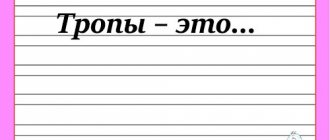3.9
Average rating: 3.9
Total ratings received: 379.
3.9
Average rating: 3.9
Total ratings received: 379.
Lexical means of expression are basic. They include various trails. This article will illustrate visual means in literature with examples.
Types of visual and expressive means
- Tropes (words with a figurative meaning): allegory, hyperbole, litotes, metaphor, metonymy, oxymoron, personification, periphrase, synecdoche, comparison, epithet.
- Stylistic figures of speech : anaphora, epiphora, parallelism, antithesis, non-union, polyunion, gradation, inversion, parcellation, ellipsis, rhetorical constructions.
- Sound writing : alliteration, assonance.
- Lexical means : archaisms, neologisms, occasionalisms, dialectisms, barbarisms, exoticisms, etc.
- Stanza , size, rhythm.
In this article we will tell you about the trails and what tasks can be associated with them.
Test "Means of Artistic Expression"
To test your understanding of the material, take a short test.
Read the following passage:
“There the war smelled of gasoline and soot, burnt iron and gunpowder, it scraped with caterpillar tracks, screeched from machine guns and fell into the snow, and rose again under fire...”
What means of artistic expression are used in the excerpt from K. Simonov’s novel?
Swede, Russian - stabs, chops, cuts.
Drumming, clicks, grinding,
The thunder of guns, stomping, neighing, groaning,
And death and hell on all sides.
A. Pushkin
What techniques does the author use to convey the tension of the battle? Determine what role the letter “r” and sound combinations with it play in the poem?
The answer to the test is given at the end of the article.
Expressive language is, first of all, an internal image that arises when reading a book, listening to an oral presentation, or a presentation. To manipulate images, visual techniques are needed. There are enough of them in the great and mighty Russian. Use them, and the listener or reader will find their own image in your speech pattern.
Study expressive language and its laws. Determine for yourself what is missing in your performances, in your drawing. Think, write, experiment, and your language will become an obedient tool and your weapon.
Answer to the test
K. Simonov. The personification of war in the passage. Metonymy: howling soldiers, equipment, battlefield - the author ideologically connects them into a generalized image of war. The techniques of expressive language used are polyunion, syntactic repetition, parallelism. Through this combination of stylistic techniques when reading, a revived, rich image of war is created.
A. Pushkin. The poem lacks conjunctions in the first lines. In this way the tension and richness of the battle are conveyed. In the phonetic design of the scene, the sound “r” plays a special role in different combinations. When reading, a rumbling, growling background appears, ideologically conveying the noise of battle.
If you were unable to give the correct answers while answering the test, do not be upset.
Just re-read the article. Previous articlePreviousNext articleNext
Allegory
Allegory is a trope; figurative expression; transfer of meanings from one subject to another; — isolation of concepts through an artistic image.
Functions of allegory
- increased imagery;
- creation of special expressiveness.
| Examples: | |
| Allegories can be introduced by the author from old fables and fairy tales, since they arose on the basis of myths. | |
| Fox | deceit |
| Wolf | greed |
| Snake | deceit |
| Bird | freedom, liberation |
| Libra, Themis | justice, impartiality |
| Scythe, Hades | death |
Lexical means: tropes
Allegory - Themis (woman with scales) - justice. Replacement of an abstract concept with a concrete image.Hyperbola — Bloomers as wide as the Black Sea (N. Gogol) Artistic exaggeration.Irony - Where are you getting your head from, smart one? (Fable by I. Krylov). Subtle mockery, used in the opposite sense to the direct one. Lexical repetition - Lakes all around, deep lakes. Repetition of the same word or phrase in the textLitota - A small man. An artistic understatement of the described object or phenomenon.Metaphor — Sleepy lake of the city (A. Blok) Figurative meaning of the word based on similarityMetonymy — The class was noisyReplacing one word with another based on the contiguity of two conceptsOccasionalisms - The fruits of education. Artistic means formed by the author.Personification - It is raining. Nature rejoices. Endowing inanimate objects with the properties of living things. Periphrase — Leo = king of beasts. Substitution of a word with an expression similar in lexical meaning.Sarcasm — The works of Saltykov-Shchedrin are full of sarcasm. Caustic, subtle mockery, the highest form of irony.Comparison -When a nightingale speaks a word, it sings. In comparison, there is both that which is compared and that with which it is compared. Conjunctions are often used: as, as if, as if. Synecdoche - Every a penny brings (money) into the house. Transfer of value based on quantitative characteristics.Epithet - “ruddy dawn”, “golden hands”, “silver voice”. A colorful, expressive definition that is based on a hidden comparison.Synonyms - 1) run - rush. 2) The noise (rustle) of leaves. 1) Words that are different in spelling, but close in meaning. 2) Contextual synonyms - words that are similar in meaning in the same context Antonyms - original - fake, callous - responsiveWords with opposite meaningsArchaism - eyes - eyes, cheeks - cheeksAn outdated word or figure of speechHyperbola
Hyperbole is a trope; figurative expression; exaggeration that sharply emphasizes the strength or significance of some phenomenon.
Hyperbole is a figurative and expressive means opposite to litotes.
Hyperbola functions
- achieving a comic or satirical effect;
- emphasizing the predominance of a phenomenon over others;
- creation of special expressiveness.
| Examples: |
| “I lived a hundred lives , And I was with you only for a moment.”; “I, and you too, have eternity in reserve ...”; “ In a hundred and forty suns the sunset was burning ”; “If I wake up before the sun and wake up at midnight, then I’ll crush the mountain. ” |
Poem "Winter Morning"
The means of expression in the poem “Winter Morning” delight with their diversity. This work is an example of the best landscape poetry.
Techniques that A.S. Pushkin uses to achieve a special mood - this is primarily an antithesis. The contrast between the gloomy yesterday and the beautiful today highlights both pictures of nature - a cold snow storm and a beautiful morning - into separate canvases. The reader seems to see both the noise of the blizzard and the blinding snow.
Special positive epithets “charming”, “magnificent”, “wonderful” emphasize the author’s mood and convey it to us. Personification is also present in poetry. The blizzard is “angry” here, and the darkness “rushed” across the gloomy sky.
Litotes
Litota - trope; figurative expression; an understatement that emphasizes the lack of strength or weakening of the significance of some phenomenon.
Functions of litotes
- emphasizing the insignificance of a phenomenon;
- creation of special expressiveness;
- achieving a comic or satirical effect.
| Examples: |
| “I have lived a hundred lives without you, And I was with you only for a moment ”; “I go outcast, homeless and poorer than the last poor. ” |
Metaphor
Metaphor - trope; figurative expression; hidden comparison.
Usually expressed through a noun or verb.
For ease of understanding, we advise you to transform the proposed expression with a noun into a comparison (Golden, ripe fruits - fruits like gold), this way you will accurately define the metaphor. If the comparison (specifically with a noun) fails, then you made a mistake.
Functions of metaphor
- increased imagery;
- creation of special expressiveness.
| Examples: |
| “ The seething cauldron of the universe ” (the universe is like a seething cauldron); “And the sun’s yellow swords pierced the first hour of midday” (the rays of the sun are like yellow swords); “ The forest is full of silence . And yellow leaves. Flocks of birds left nature: the concert hall was left without artists ” (the forest as a concert hall); “Today there was a wonderful rain – Silver carnation with a diamond head ” (rain like a carnation) |
Language means and basic language styles
There are 5 styles in Russian
There are 5 main functional styles in Russian:
- Official business.
- Scientific.
- Journalistic.
- Colloquial.
- Art.
Each style, like types of speech, has a certain set of linguistic means; we will name only the main ones.
Formal business style:
- terms (protocol, facsimile, registration, identification code, etc.);
- cliches and cliches for paperwork or colloquial speech (cause damage, in connection with which, we bring to your attention);
- frequent use of nouns and verbs;
- syntactic constructions of various structures, comparative phrases are almost never found;
- tropes, vernacular, dialectisms are not used.
Scientific style:
- terms of a certain field of science;
- cliches and cliches of the scientific style (let’s pay attention to..., the author argues his point of view..., the relevance of the chosen topic is explained);
- the advantage of verbs and nouns over other parts of speech, since scientific texts reflect processes and provide explanations for terms;
- The singular personal pronoun “I” is not used, “we” is used instead.
A feature of colloquial and artistic styles is freedom in the choice of linguistic means, the possibility of using dialects, colloquialisms, tropes, and sometimes jargon.
Different syntactic structures can be used - from the simplest to the most cumbersome.
The journalistic style has also developed its own system of concepts (mainly representing thematic groups of social vocabulary), phraseological units and cliches.
Metonymy
Metonymy - trope; figurative expression; replacing one word or expression with another based on similar meanings.
Functions of metonymy
- noticeable shortening of the author's thoughts;
- increased expressiveness.
| Examples: |
| “ Egypt went home ” (not Egypt, but the inhabitants of Egypt); “Tormented by the madness of Melpomene , in this life I thirst only for peace...” (not by Melpomene herself, but by the tragedy played in the theater (Melpomene is the muse of tragedy)). “ No one will offend the Field of Gaia “If not on silver, I ate on gold ” (not on gold in the literal sense, but on dishes made of gold); “ Watercolor in the grip of an old baguette seemed dull ” (baguette - frame made of baguette); “ Hearing the smell of foam ” (foamy is alcohol). |
Oxymoron
Oxymoron (Oxymoron) - trope; figurative expression; connection of two contradictory meanings; connection of the incompatible.
Functions of an oxymoron
- focusing readers' attention;
- unusual reflection of feelings;
- expresses the thoughts of the poet/lyrical character about the presented phenomenon
| Examples: |
| “He lies to you so richly and so poorly !”; “ The eternal moment ”; “ I ask the beggar for bread , I give to the rich for poverty , ... I hand over the key to the robber , I blush the pallor with whitewash .”; “Even then there was no place ! Even then on earth there was a home for me everywhere .”; “And in my eyes there is always Hot snow , bloody snow” |
Some tips on using language tools
Do not overuse cliches and cliches of official business, scientific style in colloquial speech.
Terminology should be consistent with the style and topic. If there are two versions of the term - Russian and foreign, give preference to the first.
Phraseologisms are used only if they know their exact meaning.
The overuse of colloquialisms and jargon in colloquial speech should become taboo: it is bad form.
In an official setting, oral speech should be based on a system of linguistic means that corresponds to the official business style.
Now you know what it is - language tools, and, having memorized their basic sets, you can competently format text of any style and type.
In this video you will learn more about the language tools of the scientific style:
Personification
Personification - trope; figurative expression; endowing inanimate objects with the properties of animate ones (the ability to think, speak, feel and act).
Impersonation functions
- increased imagery;
- creating expressiveness;
- reflection of the author's position through the choice of associative series.
| Examples: |
| “For the first time , the moon these chains and trembling... Sculpts a bust not sculpted by anyone”; “Spring, I’m from the street, where the poplar is surprised , Where the distance is afraid , Where the house is afraid to fall ,”; “And the streets of ancient Prague are silent , winding one another, But they play like ravines .” “Turning its face to the south, the Pine squints in the sun .” |
Periphrase
Periphrase - trope; figurative expression; replacing the name of a phenomenon or the name of a person by describing their essential features or indicating their characteristic features.
Paraphrase functions
- designation of a person, phenomenon, object;
- expression of the author's position;
- richness of speech by avoiding repetition.
| Examples: |
| “Here the horde followed the horde. Bringing fire and chains !” (fire and chains - war); “So to speak, a slave of honor ... struck down by a bullet...” (slave of honor - Pushkin); “ The Volga Stronghold , But the blind huts cannot be helped” (Volzhskaya Stronghold - Volgograd) |
Repeat
Repetition is a trope; figurative expression; partial or complete repetition of a word, expression, line.
Repeat functions
- sound recording enhancement;
- strengthening the quality of an object, phenomenon;
- emphasis on quantity, duration;
- achieving emotional impact.
| Examples: |
| “ Trucks sleep cranes sleep “And spins , we, the stars, and the whole ocean spins round and round .”; “But don’t be angry with me , Nadya, and don’t be angry with me , Martha.”; " We are Russians. We are children of the Volga." |
Syntactic means
Anaphora - The thunderstorm was not in vain. Repetition of words or combinations of words at the beginning of sentences or poetic lines.Antithesis - Long hair - short mind;.Contrast.Gradation - I came, I saw, I conquered! Arrangement of words and expressions in increasing (ascending) or decreasing (descending) significance.Inversion - Once upon a time there lived a grandfather and a woman. Reverse word order.Compositional junction (lexical repetition) - It was a wonderful sound. It was the best voice I've heard in years. Repeating at the beginning of a new sentence words from the previous sentence, usually ending it. Multi-union - The ocean walked before my eyes, and swayed, and thundered, and sparkled, and faded away. Deliberate use of a repeating conjunction.Oxymoron - Dead souls. A combination of words that cannot be combined in meaning.Parcellation - He saw me and froze. I was surprised. Silenced. Deliberate division of a sentence into semantically significant segments. Rhetorical question, exclamation, appeal - What a summer, what a summer! Who hasn’t cursed the stationmasters, who hasn’t sworn at them? Citizens, let's make our city green and cozy! Expressing a statement in interrogative form; to attract attention; increased emotional impact. Series, pairwise combination of homogeneous members - Nature helps to fight loneliness, overcome despair, powerlessness, forget hostility, envy, and the deceit of friends. The use of homogeneous members for greater artistic expressiveness of the textSyntactic parallelism - To be able to speak is an art. Listening is a culture. (D. Likhachev) Similar, parallel construction of phrases and lines. Default - But listen: if I owe you... I own a dagger, / I was born near the Caucasus. The author deliberately understates something, interrupts the hero’s thoughts so that the reader can think for himself what he wanted to say.Ellipsis - Guys - for the axes! (the word “taken” is missing) Omission of some member of the sentence that is easily restored from the context Epiphora - I've been coming to you all my life. I believed in you all my life. Same ending for several sentences.Synecdoche
Synecdoche - trope; figurative expression; replacing the singular with the plural and vice versa; the name of the part instead of the whole.
Synecdoche is a type of metonymy.
Functions of synecdoche
- saturation of speech by avoiding repetition;
- increased imagery;
- demonstration by the author of his skill in choosing associations / demonstration of his skill
| Examples: |
| “Working with our elbows, we ran” (elbows instead of elbows); “We all look at Napoleons” (we all want to be known as Napoleon); “The waters flowed quietly. The beetle was buzzing.." (beetle instead of beetle); “And it was heard until dawn how the Frenchman rejoiced” (the French rejoiced, and not just the Frenchman). |
in the form of a convenient table for completing task No. 26. Below is a table containing the most complete collection of means of expression (phonetic, lexical and stylistic) with definitions and examples.
I. Phonetic (sound writing)
| Example | ||
| Alliteration | Repetition of consonants creating an image | At midnight sometimes in the wilderness of the swamp / You can barely hear , silently rustle the reeds - a of hissing consonants helps convey the rustle of the reeds |
| Assonance | Vowel repetition creating an image | I love Russian birch , sometimes bright , sometimes sad - conveys slight sadness , tenderness _ _ |
II.
Lexical (tropes)
| Epithet | Colorful, figurative definition in a figurative meaning. Emphasizes the most significant features. | And you will not wash away righteous blood of the poet black . Lonely sail ; cheerful wind; chattering magpie; greedily . |
| Comparison | An expression or word in which one phenomenon or concept is explained by comparing it with another. Most often, the comparison is formalized in the form of a comparative phrase, starting with conjunctions: as, exactly, as if, as if, as if, that | Like a silent sea , the whole army is worried. Brevity, like pearls , shines with content. |
| Metaphor | A trope based on the similarity of two phenomena. Sometimes a metaphor is called a hidden comparison, since it is based on a comparison, but it is not formalized using comparative conjunctions | Diamond fly / With a cheerful noise towards the clouds - (sparkling like a diamond); Sleepy lake, dry leaves , church onions a warm welcome, a chain of mountains, the tail of a train. |
| Metonymy | Replacing one word with another of similar meaning. | Hey you, hat ! (man in a hat) Reading Bulgakov ... (his books) The entire boarding house recognized the superiority of D.I. Pisareva |
| Synecdoche | A type of metonymy: the whole is revealed through its part or vice versa | Every penny brings (money) into the house; And you could hear how the Frenchman (the French army) |
| Allegory | Depiction of an abstract concept or phenomenon through a concrete image | The fox is an allegory of cunning, the hare - cowardice |
| Irony | A word or expression used in a sense opposite to its intended meaning | You are so smart ! (=stupid) |
| Personification | The properties of a living being are attributed to an inanimate object | The trees, bending towards me, extended their thin hands . |
| Hyperbola | Exaggeration | At one hundred and forty suns the sunset glowed |
| Litotes | Understatement | Your Spitz, your lovely Spitz, is no more than a thimble ; Below a thin piece of grass You have to bow your head, So that the little orphan in the world can live a carefree life. |
| Paraphrase(s) | A word or expression is replaced by a synonymous one to avoid repetition | Leo = king of beasts Oil = black gold Spring = morning of the year |
| Synonyms | 1) Words that are different in spelling, but close in meaning. 2) Contextual synonyms - words that are similar in meaning in the same context | 1) Win-overcome; run - rush. 2) Ostankino needle (tower); talk (murmur) of waves; noise (rustle) of leaves. |
| Antonyms | Words with opposite meanings | Cunning and Love ; Whiter is only the shine, blacker is the shadow. |
| Archaism | An obsolete word or figure of speech | We are tormented by spiritual thirst, I dragged myself , and a six-winged seraphim at a crossroads ... |
| Dialectism | A word or phrase existing in a certain area ( territorial dialectism ), social group ( social dialectism ) or profession ( professional dialectism ) | The rooster is clucking , the ladle is scrunching , leveling with a rake is speeding |
| Jargon | Speech of a social group, different from the general language, containing many artificial words and expressions | “ Smell ” is from the jargon of hunters, “ amba ” is from the sea. |
| Neologism | A newly formed word that appeared in connection with the emergence of new concepts in life | " Mediocrity " instead of "mediocrity" |
| Aphorism | A generalized, deep thought of the author, distinguished by precise expressiveness and obvious unexpectedness of judgment. The aphorism has an author | “The powerful are always to blame for the powerless” |
| Phraseologism | Lexically indivisible, stable, integral in meaning phrase, reproduced in the form of a ready-made speech unit | To kick the bucket, hand on heart, bury talent in the ground, bosom friend, sworn enemy, delicate situation |
III. Stylistic figures
| Anaphora (lexical repetition) | Repeating parts at the beginning of lines (unity of beginning) | This morning, this joy, This power of day and light, This blue vault, This cry and strings, These flocks, these birds... |
| Epiphora (lexical repetition) | Repetition of parts, same syntactic construction at the end of sentences | to you all my life . in you all my life . you all my life . |
| Compositional junction (lexical repetition) | Repetition at the beginning of a new sentence of a word or words from a previous sentence, usually ending it | Motherland did everything for me . homeland taught me, raised me, and gave me a start in life . A life I'm proud of. |
| Antithesis | Opposition | Long hair - short ; Yesterday I was choking with happiness, and today I am screaming in pain. |
| Gradation | Arrangement of synonyms according to the degree of increase or decrease of the characteristic | Huge blue eyes glowed , burned , and shone on her face But you must understand this loneliness, accept it, make friends with it and overcome it ... |
| Oxymoron | Connecting words that contradict each other, logically exclude each other | Look, it’s fun for her to be sad so elegantly naked . Dead souls , living corpse , hot snow |
| Inversion | Changing the usual word order. Usually: attribute + subject + adverbial + predicate verb + object (e.g. The autumn rain was loudly knocking on the roof) | He came - he came ; It was a shame, they were expecting a fight ; He passed the doorman and flew up the marble steps like an arrow . – (cf. “he flew past the doorman like an arrow”) |
| Parallelism | Comparison in the form of juxtaposition | Parallelism can be direct : The graves are overgrown with grass - is overgrown and the negative one , in which the coincidence of the main features of the compared phenomena is emphasized: It is not the wind that bends the branch, is not the oak tree that makes noise - It is my heart that groans, Like an autumn leaf trembling. |
| Ellipsis | Omission of some part of the sentence that is easily restored from the context | Guys - for the axes! (the word “taken” is missing) |
| Parcellation | Division of a single meaning statement into independent sentences | And again Gulliver. Costs. Slouching. |
| Polyunion (polysyndeton) | Homogeneous members or sentences connected by repeating conjunctions | How strange, and alluring, and carrying, and wonderful is the word road! And how wonderful this road itself is. |
| Asyndeton | Homogeneous members of a sentence are connected without the help of conjunctions | Swede, Russian stabs, chops, cuts ... |
| Rhetorical exclamation | An exclamation that enhances the expression of feelings in the text | Who hasn't scolded the stationmasters?! |
| A rhetorical question | A question that is asked not with the goal of giving or receiving an answer, but with the goal of having an emotional impact on the reader | What Russian doesn't like driving fast ? = “all Russians love” |
| Rhetorical appeal | An appeal directed not to a real interlocutor, but to the subject of an artistic depiction | Farewell, unwashed Russia ! |
| Default | Deliberate interruption of speech in anticipation of the reader's guess, who must mentally complete the phrase | But listen: if I owe you ... I own a dagger, / I was born near the Caucasus. |
| Paradox | A judgment that is sharply contrary to common sense, but deep in meaning | A coward dies many times, a brave man only once; Hurry up slowly; The worse the better |
| Evaluative vocabulary | Direct author's assessment of events, phenomena, objects | Pushkin is a miracle . |
| Expressive vocabulary | Words expressing affection, joke, irony, disapproval, disdain, familiarity, etc. | Fool, son, silly, rhymer, dunce, drunkard, talker |
This table does not represent all means of expression. In a more convenient and complete form (pdf format) you can download this topic from the links below.
Complete collections of materials on the Russian language are available below: Collection of materials for the Unified State Exam in the Russian language Collection of materials for the Unified State Exam in the Russian language
Comparison
Comparison is a trope; figurative expression; comparison of one object/phenomenon with another.
Usually, comparison is achieved with the help of conjunctions like, so, exactly, as if, like, that, as if, etc.
Comparison functions
- creating richness of speech;
- creation of special expressiveness.
| Examples: |
| “I am leaving the bottomless, as if there is a bottom to something”: “My perceptions are still washing over me like streams ”; “You looked at me, as if encouraging me ”; “I lived like a stupid puppy ”; “And the plows and plows float, silver, along the ax, like seagulls in the morning...” |
How to determine the type of trail
Determining means of expression is truly a difficult task. It is very easy to get confused in all sorts of definitions and features. Using examples from different literary texts, we will analyze all the ways of defining tropes.
Means of expression and their definition. Algorithm
In order to start working with text, you always need to have a specific action plan or algorithm that will help you not miss anything important. To determine the type of trail or figure, you must follow these steps:
- carefully read the source text several times;
- understand the main essence and meaning that the author was trying to convey;
- analyze each sentence for the presence of means of expression and determine their types;
- sign all the necessary information in pencil above the proposals;
- enter into the task the answer options that were required of you.
If you strictly follow this rule, then the task will be completed without errors.
Examples of defining a means of expression. Artistic text
Now let's look at how to do this work on a specific text. It is necessary to develop practical skills in performing this kind of tasks, because then it will be quite easy to distinguish them from each other.
Let's analyze each proposal:
- 1 and 2 – there are rows of homogeneous members of the sentence, that is, syntactic means of expressiveness;
- 3 – no speech means;
- 4 and 5 – exclamatory sentences, that is, syntactic means of expressiveness;
- 6 – rows of homogeneous members of the sentence;
- 7 – no trails;
- 8 – comparison, refers to such a means of expression as a trope.
Thus, it is necessary to analyze each sentence of the presented text so as not to make a mistake in determining the means. The tables presented will help you quickly and efficiently learn the theory on this issue.







